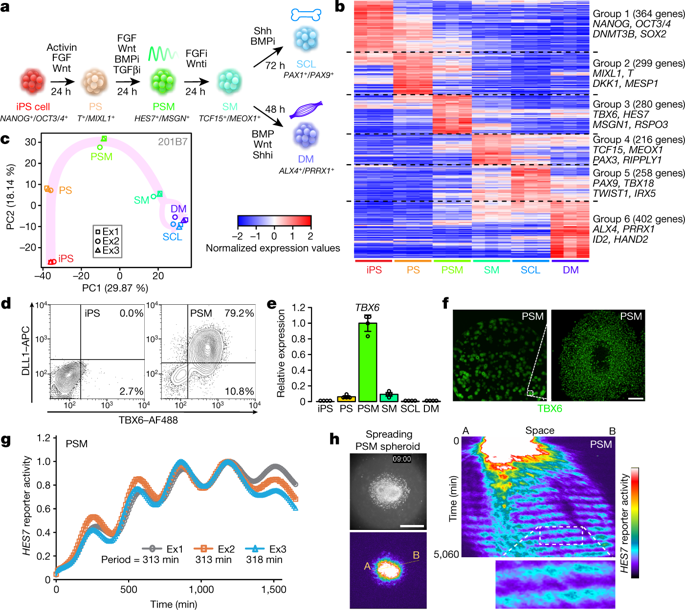Nature ( IF 50.5 ) Pub Date : 2020-04-01 , DOI: 10.1038/s41586-020-2144-9 Mitsuhiro Matsuda 1, 2 , Yoshihiro Yamanaka 3, 4 , Maya Uemura 3, 5 , Mitsujiro Osawa 6 , Megumu K Saito 6 , Ayako Nagahashi 6 , Megumi Nishio 5 , Long Guo 7 , Shiro Ikegawa 7 , Satoko Sakurai 8 , Shunsuke Kihara 9 , Thomas L Maurissen 8 , Michiko Nakamura 8 , Tomoko Matsumoto 8 , Hiroyuki Yoshitomi 3, 5 , Makoto Ikeya 8 , Noriaki Kawakami 10 , Takuya Yamamoto 4, 8, 11, 12 , Knut Woltjen 8 , Miki Ebisuya 1, 2 , Junya Toguchida 3, 5 , Cantas Alev 3, 4

|
Pluripotent stem cells are increasingly used to model different aspects of embryogenesis and organ formation1. Despite recent advances in in vitro induction of major mesodermal lineages and cell types2,3, experimental model systems that can recapitulate more complex features of human mesoderm development and patterning are largely missing. Here we used induced pluripotent stem cells for the stepwise in vitro induction of presomitic mesoderm and its derivatives to model distinct aspects of human somitogenesis. We focused initially on modelling the human segmentation clock, a major biological concept believed to underlie the rhythmic and controlled emergence of somites, which give rise to the segmental pattern of the vertebrate axial skeleton. We observed oscillatory expression of core segmentation clock genes, including HES7 and DKK1, determined the period of the human segmentation clock to be around five hours, and demonstrated the presence of dynamic travelling-wave-like gene expression in in vitro-induced human presomitic mesoderm. Furthermore, we identified and compared oscillatory genes in human and mouse presomitic mesoderm derived from pluripotent stem cells, which revealed species-specific and shared molecular components and pathways associated with the putative mouse and human segmentation clocks. Using CRISPR–Cas9-based genome editing technology, we then targeted genes for which mutations in patients with segmentation defects of the vertebrae, such as spondylocostal dysostosis, have been reported (HES7, LFNG, DLL3 and MESP2). Subsequent analysis of patient-like and patient-derived induced pluripotent stem cells revealed gene-specific alterations in oscillation, synchronization or differentiation properties. Our findings provide insights into the human segmentation clock as well as diseases associated with human axial skeletogenesis.
中文翻译:

用多能干细胞重现人类分段时钟
多能干细胞越来越多地用于模拟胚胎发生和器官形成的不同方面1 。尽管最近在体外诱导主要中胚层谱系和细胞类型2,3方面取得了进展,但能够概括人类中胚层发育和模式的更复杂特征的实验模型系统在很大程度上缺失。在这里,我们使用诱导多能干细胞在体外逐步诱导前体中胚层及其衍生物,以模拟人类体节发生的不同方面。我们最初专注于对人类节段时钟进行建模,这是一个重要的生物学概念,被认为是体节有节奏和受控出现的基础,体节产生了脊椎动物轴向骨骼的节段模式。我们观察了核心分节时钟基因(包括HES7和DKK1)的振荡表达,确定人类分节时钟的周期约为 5 小时,并证明在体外诱导的人前体中胚层中存在动态行波样基因表达。此外,我们鉴定并比较了源自多能干细胞的人类和小鼠前体中胚层中的振荡基因,这揭示了与假定的小鼠和人类分段时钟相关的物种特异性和共享的分子成分和途径。然后,我们使用基于 CRISPR-Cas9 的基因组编辑技术,针对已报告椎骨分段缺陷(例如脊椎肋骨发育不全)患者的突变基因( HES7 、 LFNG、DLL3和MESP2 )。 随后对患者样和患者来源的诱导多能干细胞的分析揭示了振荡、同步或分化特性的基因特异性改变。我们的研究结果提供了对人类分段时钟以及与人类轴向骨骼发生相关的疾病的见解。











































 京公网安备 11010802027423号
京公网安备 11010802027423号